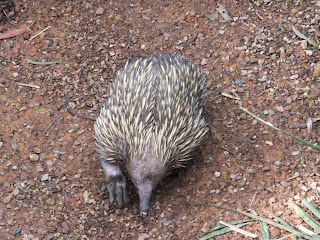About 2 hours outside Melbourne is the Healesville Sanctuary. It is part of the Melbourne Zoo complex, but showcases only native Australian animals and birds. Neither of us are very keen on zoos, but since so many of Australia's animals are nocturnal, smallish and often adapted to live in trees, this was a great way to see them. Marsupials (pouched mammals who's underdeveloped newborns complete their development in their mother's pouch) are so energy-efficient that they need to eat one fifth less food than equivalent sized placental mammals. We enjoyed learning more about them.
 |
| The beautiful eagle statue at the entrance. |
They have enclosures where a combination of animals live together in a certain habitat and they do shows in the arena. We were extremely impressed with the raptor show which was outstanding and showcased some really impressive raptors, parrots and cockatoos flying 'up close' while they told you about them.
 |
| The busy little echidna running around |
Ever wondered why kangaroos hop? It turns out that hopping is the most efficient way to get around at medium speeds. This is because the energy of the bounce is stored in the tendons in their legs and their intestines bounce up and down, pumping their lungs full of air without them needing to use their chest muscles!
 |
| A lazy red kangaroo. We definitely did not expect to see them like this! All he needs is a cocktail with a little umbrella in it.... |
 |
| Mom and joey kangaroo - odder looking than we expected! Do you notice how much of their weight sits on their tails? |
 |
| The Monitor Lizard at the reptile display, similar in size to the Legavaans back home, but with some funky colours. Geoff had never touched one before. |
 |
| Mr Red Tailed Black Cockatoo - his wife was also impressive with gold flecks over her body and yellow and red in her tail. |
 |
| Lucy feeding an Eclectus Parrot |
 |
| The Blue-faced Honeyeater |
 |
| A cute little Zebra Finch |
 |
| The Green Parrots, like the Rosellas, loved Geoff's hair! |
 |
| These little guys were so friendly and playful. |
At the koala enclosure there wasn't much activity - just fur balls up in the trees. We didn't blame them as it was pretty chilly. The Volunteer suggested we come back at feeding time when they come down out of the trees.
 |
| Mmmm... fresh gum leaves! |
We were rewarded with a little joey koala clambering around on his mum! So cute! That morning was the first morning that his mum had been secreting a special type of faeces for him to eat called pap which provides him with the necessary bacteria to break down the tannins in the Gum leaves, so he was excitedly nibbling here and there.
 |
| Curious little fellow. |
 |
| Cuddled up again in a warm little ball. |
We read the following in the Lonely Planet about koalas:
"If you visit a wildlife park or zoo, you will notice the faraway look in a koala's eyes. It seems as if nobody is home - and this is in fact near to the truth. Several years ago biologists announced that koalas have very small brains compared to the size of their skulls..... and we now believe that they have sacrificed their brain for energy efficiency. Brains cost a lot to run - ours typically weigh 2% of our body weight and use 20% of the energy that we consume. Koalas eat gum leaves which are so toxic that they use 20% of their energy just detoxifying this food. This leaves little energy for their brain, and living in the treetops where there are so few predators for a large animal means that they can get by with few wits at all."
We're not sure what the zookeepers would say to that!
 |
| A fuzzy wombat |
 |
| The Rock Wallaby - the equivalent to our Klipspringer |
The Sanctuary had an interesting campaign running called "Wipe for Wildlife". Back home we're encouraged to use toilet paper made from recycled paper or pulp by-product from sugar production, etc as a more sustainable option (and generally it isn't bleached and washed and so uses less water and doesn't pollute that water) to toilet paper made from trees planted in a plantation. In Aus, this is a real issue as indigenous forest is stripped, pulped and exported to countries that turn that pulp into toilet paper and send it back to Aus. In Tasmania some of the forests being logged are hundreds of years old. This type of habitat loss is the biggest threat to Australian forest wildlife (along with foxes and feral cats) and there is a big campaign to protect this wildlife by buying toilet paper made from a responsible source. Their advertising campaign was interesting and we found these posing boards at the sanctuary.
 |
| We thought Geoff's one was particularly appropriate/funny! |


















No comments:
Post a Comment